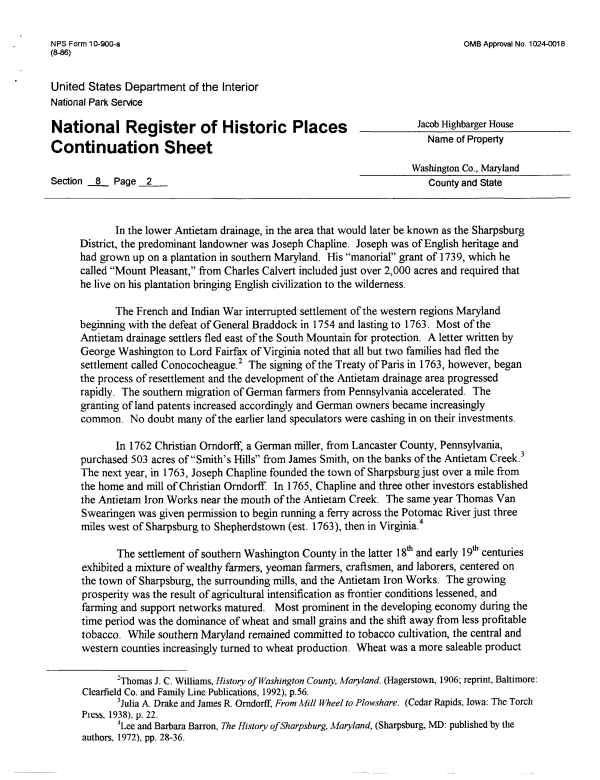 |
||||
|
DEPARTMENT OF HOUSING AND COMMUNITY DEVELOPMENT, MARYLAND HISTORICAL TRUST (Historic Sites Survey) var.d. MSA SE16-10 Image No: se16-10-0415 Enlarge and print image (74K) |
 |
||||
|
DEPARTMENT OF HOUSING AND COMMUNITY DEVELOPMENT, MARYLAND HISTORICAL TRUST (Historic Sites Survey) var.d. MSA SE16-10 Image No: se16-10-0415 Enlarge and print image (74K) |
| NPS Form 10-900-a OMB Approval No. 1024-0018 (8-86) United States Department of the Interior National Park Service Jacob Highbarger House National Register of Historic Places __ r* i_. .. «*, . Name of Property Continuation Sheet Washington Co., Maryland Section _8_ Page _2_ County and State In the lower Antietam drainage, in the area that would later be known as the Sharpsburg District, the predominant landowner was Joseph Chapline. Joseph was of English heritage and had grown up on a plantation in southern Maryland. His "manorial" grant of 1739, which he called "Mount Pleasant," from Charles Calvert included just over 2,000 acres and required that he live on his plantation bringing English civilization to the wilderness. The French and Indian War interrupted settlement of the western regions Maryland beginning with the defeat of General Braddock in 1754 and lasting to 1763. Most of the Antietam drainage settlers fled east of the South Mountain for protection. A letter written by George Washington to Lord Fairfax of Virginia noted that all but two families had fled the settlement called Conococheague.2 The signing of the Treaty of Paris in 1763, however, began the process of resettlement and the development of the Antietam drainage area progressed rapidly. The southern migration of German farmers from Pennsylvania accelerated. The granting of land patents increased accordingly and German owners became increasingly common. No doubt many of the earlier land speculators were cashing in on their investments. In 1762 Christian OrndorfT, a German miller, from Lancaster County, Pennsylvania, purchased 503 acres of "Smith's Hills" from James Smith, on the banks of the Antietam Creek.3 The next year, in 1763, Joseph Chapline founded the town of Sharpsburg just over a mile from the home and mill of Christian Orndorff. In 1765, Chapline and three other investors established the Antietam Iron Works near the mouth of the Antietam Creek. The same year Thomas Van Swearingen was given permission to begin running a ferry across the Potomac River just three miles west of Sharpsburg to Shepherdstown (est. 1763), then in Virginia.4 The settlement of southern Washington County in the latter 18th and early 19th centuries exhibited a mixture of wealthy farmers, yeoman farmers, craftsmen, and laborers, centered on the town of Sharpsburg, the surrounding mills, and the Antietam Iron Works. The growing prosperity was the result of agricultural intensification as frontier conditions lessened, and farming and support networks matured. Most prominent in the developing economy during the time period was the dominance of wheat and small grains and the shift away from less profitable tobacco. While southern Maryland remained committed to tobacco cultivation, the central and western counties increasingly turned to wheat production. Wheat was a more saleable product 2Thomas J. C. Williams, History of Washington County, Maryland. (Hagerstown, 1906; reprint, Baltimore: Clearfield Co. and Family Line Publications, 1992), p. 56. 3Julia A. Drake and James R. Orndorff, From Mill Wheel to Plowshare. (Cedar Rapids, Iowa: The Torch Press. 1938), p. 22. 4Lee and Barbara Barren, The History of Sharpsburg, Maryland, (Sharpsburg, MD: published by the authors, 1972), pp. 28-36. |